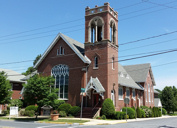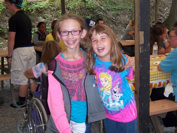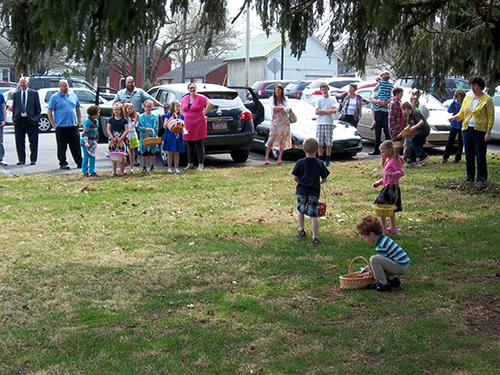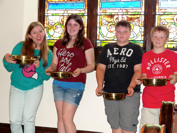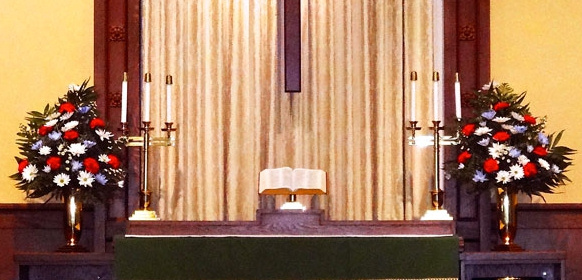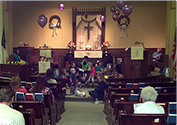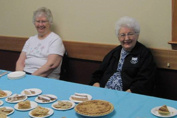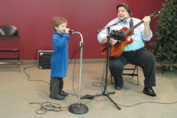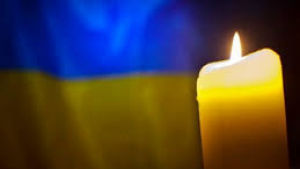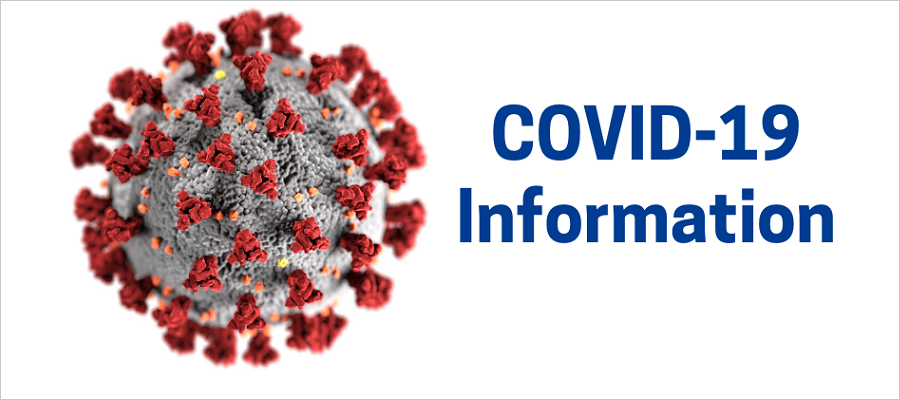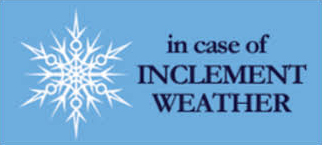Church History
History of Our Church
Following Christ and serving God within our community since 1876.
On this page:
Brief Overview of the History of the UCC
Brief Overview of the History of St. Paul’s UCC
Detailed Overview of the History of St. Paul’s UCC
Brief Overview of the History of the United Church of Christ
The United Church of Christ is both a very old and very young denomination. It is young in the sense that it the denomination was formed 1957 by the merger of two other denominations: the Evangelical and Reformed Church (E&R) and the Congregational Christian Church (C-C). The E&R Church was formed by a previous 1934 merging of the German Evangelical Church and the German Reformed Church denominations. The C-C Church was formed by a previous 1931 merging of the Congregational Church and the Christian Church denominations.
The United Church of Christ is an old denomination in the sense that the aforementioned German Reformed Church began in Pennsylvania in the early 1700s, with the first German Reformed pastor being John Philip Boehm in 1725 (with his first church being in what is now Montgomery County). The aforementioned Congregational Church began in 1620 as the denomination that formed from the landing of the Pilgrims and the Puritans in Massachusetts. Both of these were of the “Reformed Theological Tradition”, as part of the Protestant Reformation which formally began in 1567.
Thus the United Church of Christ is simultaneously a very old and a relatively young Protestant denomination.
Brief Overview of the History of St. Paul’s United Church of Christ
The history of St. Paul’s United Church of Christ (UCC) begins with the Protestant Reformation in Europe in the 1500s, it continues with the first German settlers in the Pennsylvania in the early 1700s, and culminates in a partnership in ministry between the German Reformed and German Lutheran settlers in the Robesonia area in the 1800s, a partnership which has expanded and continues to flourish today.
St. Paul’s United Church of Christ came into being through the merger of two German Reformed congregations worshiping in Robesonia. In 1904 the congregations of, “St. Daniel’s Reformed Congregation” (founded in 1876) and “St. Paul’s Reformed Congregation in the Furnace Chapel” (founded in 1888) voted to merge and become one congregation “St. Paul’s Reformed Church of Robesonia.” They began construction that year, completing the new church building at our current location in February of 1905, with the first worship service held on March 5, 1905.
St. Daniel’s Reformed Church was founded in 1876. St. Daniel’s Reformed Church paid rent to St. Daniel’s Lutheran Church to meet in their already existing church building.
St. Paul’s Reformed Church was founded in 1888. The congregation met at the Robesonia Furnace Chapel, also known as Union Chapel. The Furnace Chapel was a non-denominational building used by a variety of religious groups. This is the current location of present day Trinity Evangelical Lutheran Church of America (ELCA) in Robesonia.
St. Paul’s UCC continues to have valued ties with our Lutheran sisters and brothers. We share together in ministry as a part of the Conrad Weiser Ministerium. We have occasional shared worship services, such as during Lent, Thanksgiving Eve, and the Conrad Weiser Baccalaureate Service. The Heidelberg Cemetery continues to be managed jointly with a board composed of members from St. Daniel’s ELCA, St. Paul’s UCC, and Trinity ELCA churches.
A More Detailed Overview of St. Paul’s History
1723 - The Early Years of Robesonia
In the 1700s German speaking immigrants who were of the German Reformed and German Lutheran churches began arriving in Pennsylvania.
In 1723 the first group of German settlers arrived in this area to form the Tulpehocken settlement. These initial settlers were primarily farmers who came at the invitation of Pennsylvania Governor William Keith, to escape the mistreatment they were experiencing in New York as German immigrants. Many of these settlers were of the German Reformed and Lutheran faith.
1794 - Robesonia Furnace
From 1794 until 1927 (when Bethlehem Steel purchased the furnace and dismantled it to reduce competition), Robesonia was an iron furnace town. Robesonia is named for Henry P. Robeson, the son of British immigrants. He and his partner Clement Brooke bought the furnace from the original owner George Ege in 1854. The town was initially called Heidelbergstown, then Robesonia Furnace, and finally in 1859 it became Robesonia. The borough was incorporated in 1913. The southern part of the borough contains the Robesonia Furnace Historic District (listed on the National Register of Historic Places in 1991), and as you venture off of Penn Avenue you can drive through the rolling hills of picturesque farmland. Robesonia is now commonly known as “The Garden Spot of Lebanon Valley.”
1751 - The Beginning of Heidelberg Lutheran Church (St. Daniel’s Lutheran Church)
In 1751 Johannes Artz, Abraham Lauch, and Michael Schauer donated property where their three farms joined. The deed was signed by Conrad Weiser, as justice of the peace. They began constructing a stone church in 1751, which was completed in 1754. The congregation was founded as Heidelberg Lutheran Church. As the church was made of three “corners” of farm land, it was more commonly known as “Eck Kirche” or “Corner Church.” That first building was located at the present Memorial site at the intersection of North Church Street and St. Daniels Road.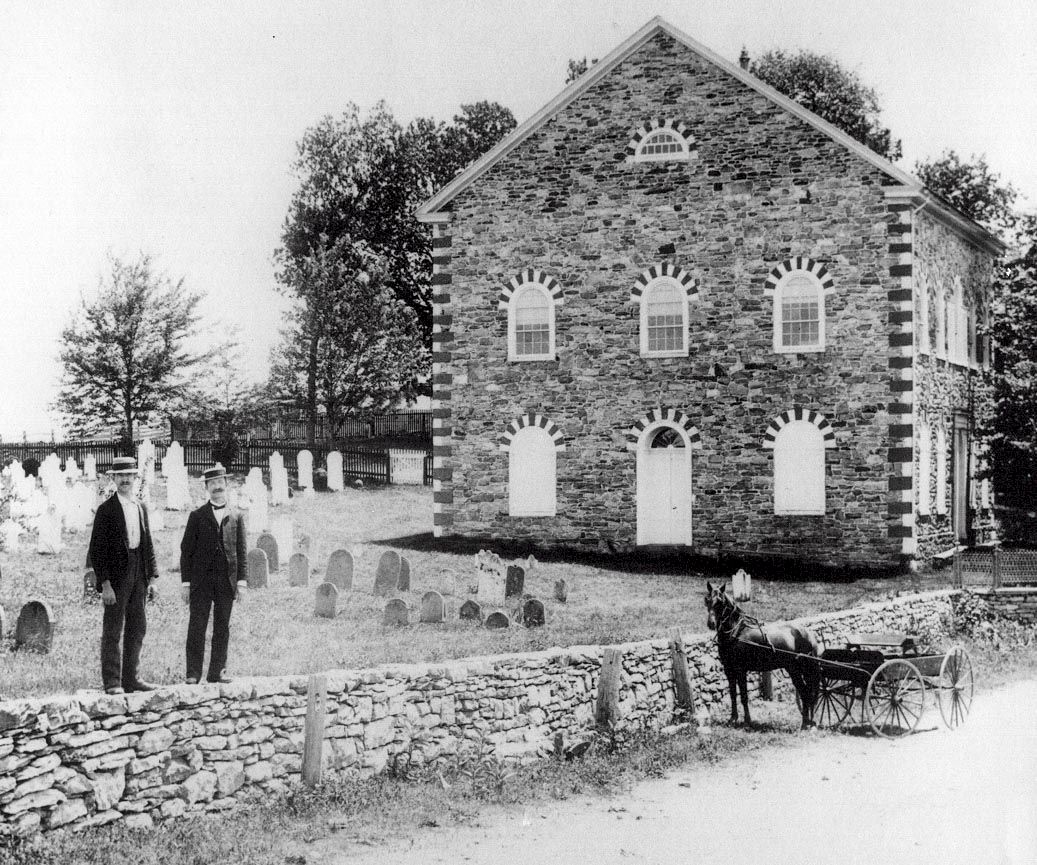 In 1773 more land was purchased. The Lutheran congregation built a second church on the south east corner of North Church Street and Big Spring Road beginning in1814, completed in 1817, and remodeled it in 1849. The congregation named the church after their pastor, the Rev. Daniel Ulrich (who served their congregation from 1811-1853). The Memorial site was created after a fire on December 8, 1976 destroyed the historic church and educational building. The current St. Daniel’s Lutheran Church was constructed in 1978.
In 1773 more land was purchased. The Lutheran congregation built a second church on the south east corner of North Church Street and Big Spring Road beginning in1814, completed in 1817, and remodeled it in 1849. The congregation named the church after their pastor, the Rev. Daniel Ulrich (who served their congregation from 1811-1853). The Memorial site was created after a fire on December 8, 1976 destroyed the historic church and educational building. The current St. Daniel’s Lutheran Church was constructed in 1978.
1876 - The Beginning of St. Daniel’s Reformed Church
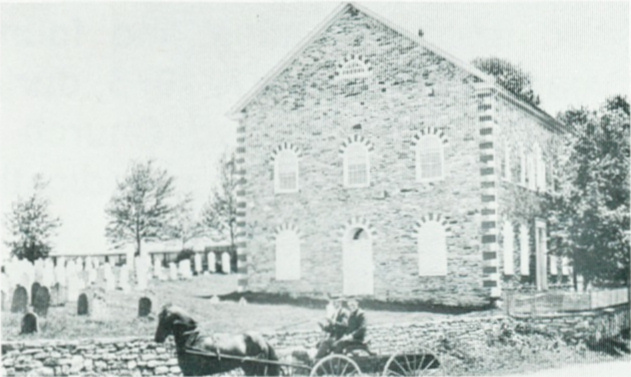 In the summer of 1876 the German Reformed people of the eastern end of the original Tulpehocken settlement decided to form a congregation. Not wanting to travel a great distance and in need of a place to worship, they approached St. Daniel’s Lutheran Church for permission to hold services there. An agreement was worked out which included a charge of $1.00 per year, with expenses for maintenance and repair shared equally.
In the summer of 1876 the German Reformed people of the eastern end of the original Tulpehocken settlement decided to form a congregation. Not wanting to travel a great distance and in need of a place to worship, they approached St. Daniel’s Lutheran Church for permission to hold services there. An agreement was worked out which included a charge of $1.00 per year, with expenses for maintenance and repair shared equally.
On September 2, 1876 the St. Daniel’s German Reformed Congregation was formed, and the Rev. Thomas C. Leinbach was elected as their pastor. The first communion was celebrated on Christmas Day in 1876 with twenty-nine people receiving the sacrament. Additional land was purchased in 1880 (totaling 10 acres). The “Corner Church” was renovated in 1883 with both congregations sharing in the expense and work.
St. Daniel’s Reformed Congregation was a part of the “Bernville Charge.” A “charge” is when one pastor serves two or more congregations at one time, generally to share the cost of pastoral leadership. At the time, the Bernville Charge, served by the Rev. Leinbach, included five other Reformed Churches: North Heidelberg, St. Thomas-Bernville, Christ (Little Tulpehocken), Host, and Zion’s Strausstown. These churches were part of the third district of the Lebanon Classis of the Synod of German Reformed Churches.
1869 - Furnace Chapel
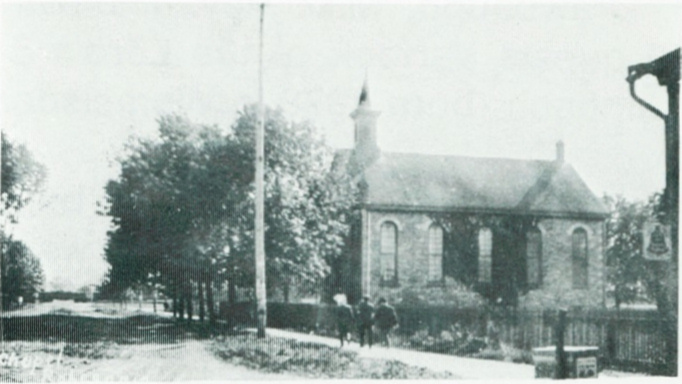 In 1869 the Furnace Chapel (also known as the “Union Chapel” and the “Robesonia Chapel”) was built, as a nondenominational place of worship, on South Robeson Street in Robesonia by Nathanial Ferguson, one of the owners of the Robesonia Furnace. It is now the location of Trinity Evangelical Lutheran Church of America (ELCA).
In 1869 the Furnace Chapel (also known as the “Union Chapel” and the “Robesonia Chapel”) was built, as a nondenominational place of worship, on South Robeson Street in Robesonia by Nathanial Ferguson, one of the owners of the Robesonia Furnace. It is now the location of Trinity Evangelical Lutheran Church of America (ELCA).
1888 - The Beginning of St. Paul’s Reformed Church at the Furnace Chapel
On July 11, 1888, the Rev. Thomas M. Yundt organized the St. Paul’s German Reformed Congregation. The Rev. Yundt was also the Superintendent of Bethany Orphans Home in Womelsdorf (first founded in 1863 to care for orphans of the American Civil War). That first St. Paul’s German Reformed congregation began meeting in the Furnace Chapel. In 1889, the Lebanon Classis added St. Paul’s to the congregation at Bethany Orphan’s Home as part of the Bethany Charge. The congregation of St. Paul’s has a long history of strong involvement and support of what is now called the Bethany Children’s Home, and that support continues to present day.
1903 - Merging of St. Daniel’s Reformed Church and St. Paul’s Reformed Church
The Rev. Thomas Leinbach was getting older and St. Daniel’s Reformed Church was growing, so in 1903 the Rev. Edwin S. Leinbach was elected as Associate Pastor to his father. In the early 1900s, the congregation of St. Daniel’s German Reformed Church wanted to have their own building. On December 26, 1903, St. Daniel’s German Reformed Church met and voted to leave the Corner Church and join with another Reformed congregation in town. On December 27, 1903 the Consistories of St. Daniel’s and St. Paul’s German Reformed Churches met and unanimously agreed to merge and build a new church together.
1904 - A New Building for the New St. Paul’s United Church of Christ
What is in the Corner Stone
In the winter of 1904, two lots were purchased on the northwest corner of Penn Avenue and Pearl Street from William H. Livingood. Five hundred people were present for the laying of the corner stone the summer of 1904. Sermons were preached and anthems were sung in both German and English. The following items were placed in the Corner Stone: copies of the Bible, the Heidelberg Catechism, the Reformed Church Messenger, the Reformed Church Record, the Reformed Church Almanac, and The Reading Eagle; sacramental bread and wine; a Proclamation with a list of the Building Committee, the present officers and pastors of the congregation, and other ministers present; plus a copy of the service itself. The building was completed in the winter of 1905. The first regular worship service was held on March 5, 1905. Sermons were preached in both English and German by the Rev. Thomas Leinbach and his son the Rev. Edwin Leinbach.
1907 - Additional Land & the First Organ
In 1907 two further lots just west of the church were purchased from the Livingood family. The first church organ was purchased with the help of a donation from the Andrew Carnegie Foundation.
During that same year, the founding pastor of St. Paul's Reformed Church at the Robesonia Chapel died. His obituary can be found on our website by clicking on the following link: In Loving Memory of the Rev. Thomas M. Yundt.
1909 - Death of the First Pastor
In less than a month after the church had paid off its mortgage, the first pastor of the merged St. Paul’s Reformed Church and founding pastor of St. Daniel's German Reformed Church, the Rev. Thomas C. Leinbach, died on May 1, 1909, after having served nearly 50 years as the pastor of St. Paul’s (33 of which as the pastor of St. Daniel’s German Reformed Church). The church was draped in black in mourning his death.
His obituary can be found on our website by clicking on the following link: In Loving Memory of The Rev. Thomas C. Leinbach.
Later that year, the size of the charge was reduced to half, with the Rev. Edwin S. Leinbach being elected to serve what became known as the “Robesonia Charge,” which included St. Paul’s, St. John’s (Host), Robesonia and North Heidelberg Reformed congregations.
1912 - Electric Lights
In 1909, the Consistory began considering changing from gas to electric lights, which were finally installed in 1912.
1918 - End of German Worship Services
The Era of World War I (1914-1918)
It was decided that St. Paul’s would have four evening services in English and one morning service in German every month, but because of the First World War with Germany, the German services were discontinued by July 1918.
1922 - The Building of the Parsonage
At the end of 1922, the congregation voted to build a parsonage; it was finally built four years later, and the Rev. Leinbach and his family moved into it in December 1926.
1924 - Monthly Consistory Meetings
Since 1905 the Consistory had met quarterly. Beginning in July 1924, it began to meet monthly, and as of today continues to meet nearly monthly.
1930s - Fastnachts
In the 1930s an important fund-raiser was the making and selling of fastnachts. St. Paul’s fastnachts were in such high demand, that members would stay up all night at the church baking them in order to make enough for all who wanted to purchase them.
1930 - Building Plans Effected by the Great Depression
The Era of the Great Depression (1929-1940s)
Era of World War II (1939-1945)
All this time the Sunday School had been growing and needed more space. Additions to the existing church building were being planned in 1930, but they were abandoned because of the stock market crash and the Depression. The Sunday School held sessions in the sanctuary instead. Although the 1930’s were difficult times, the church managed to install a new oil heating system in 1936. The church’s heating system was temporarily re-converted to coal because of oil shortages during World War II, but the oil heating system was reinstalled after the war.
1940s - Sanctuary Stage
The Christmas programs that took place in the sanctuary in the 1940s were so elaborate that the pulpit and lecturn were temporarily removed during Advent and a stage was built over the lower chancel area, in order to extend the upper chancel floor all the way to the chancel railing.
1942 - Brick Bell Tower
In 1942 the original wooden bell tower was replaced by a brick bell tower.
1945 - Mother/Daughter Banquet
In 1945 a fondly remembered Mother/Daughter Banquet was held at St. Paul’s.
1946 - Death of St. Paul’s Second Pastor
This second era of St. Paul’s came to an end with the death of Rev. Leinbach in April 1946 (serving the congregation as pastor or associate pastor for 43 years). His sudden death came as quite a shock to the congregation. For seventy years since its beginning in 1876 as St. Daniel’s German Reformed Church, the congregation had been shepherded by the father and son Leinbach pastors.
His obituary can be found on our website by clicking on the following link: In Loving Memory of The Rev. Edwin S. Leinbach.
1946 - St. Paul’s Third Pastor
Following a search process, the Rev. Elmer A. Dech became the pastor of the Robesonia Charge, preaching his first sermon in November 1946. He served as St. Paul’s pastor for 28 years until his resignation in November 1974. He continued to live in the area following his retirement, and the congregation honored him with the title “Pastor Emeritus” for his years of faithful service. The Rev. Dech died on December 17, 1997. You can read his obituary by clicking on the following link: In Loving Memory of The Rev. Elmer Dech.
1948 - New Organ & Hershey Park
The Allen Organ still used for worship today was purchase in 1948.
In the summer of 1948, the Sunday school organized a trip by train to Hershey Amusement Park.
1950s - Conrad Weiser Kindergarten Classes at St. Paul’s
In the 1950s, the Conrad Weiser Area School District was feeling the effects of the baby boom, and for several years the school rented the church’s Sunday School rooms for weekday Kindergarten classes.
In the 1950s the stain glass window facing Penn Avenue was backlit, so that persons outside the building could see the picture, as a way to be a presence of God’s hope and light in our community.
1951 - Sanctuary Renovation
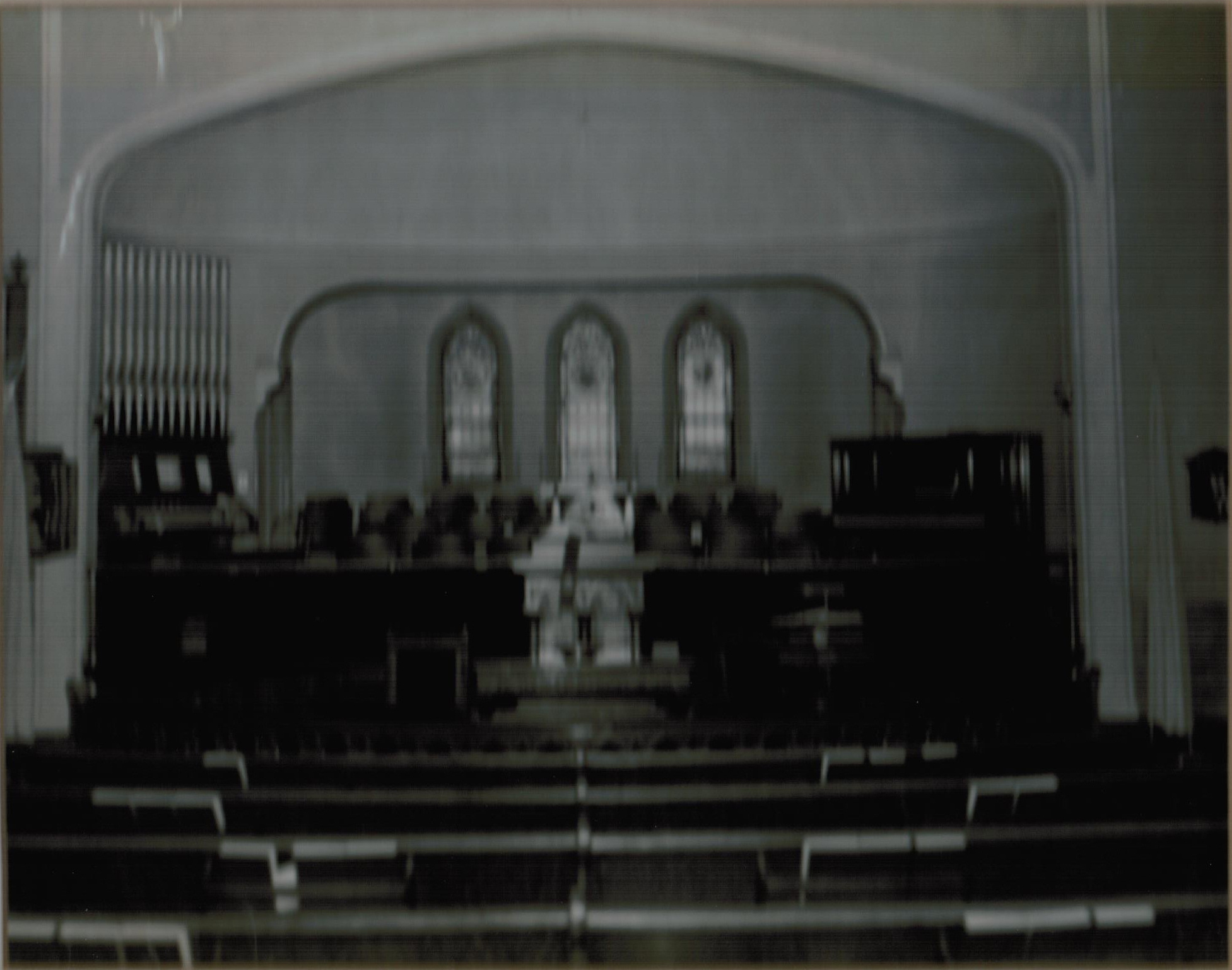 The church sanctuary was completely renovated to its present appearance in 1951. To the right is a photo of the chancel before the 1951 renovation.
The church sanctuary was completely renovated to its present appearance in 1951. To the right is a photo of the chancel before the 1951 renovation.
1960 - Additional Land
In the 1960s land was purchased for a parking lot.
1960s - VBS
In the 1960s Vacation Bible School (VBS) was a two week long program. In the 1960s St. Paul’s hosted a Good News Club.
1963 - Robesonia-Wernersville Charge
In 1963 St. Paul’s left the Robesonia Charge and partnered with First Church in Wernersville in a two-point Robesonia – Wernersville Charge.
1974 - Retirement of Third Pastor - First Pastor Emeritus
In November of 1974, the Rev. Elmer A. Dech retired, and the congregation honored him with the title “Pastor Emeritus.” You can read his obituary by clicking on the following link: In Loving Memory of The Rev. Elmer Dech.
1975 - St. Paul’s Fourth Pastor
On September 1, 1975, the Rev. George J. Miller was called as pastor of the Robesonia-Wernersville Charge.
1970s - Center Aisle
In the 1970s a center aisle was created in the church sanctuary, and Susan Zerbe Morgan was the first bride to walk the center aisle during her wedding ceremony.
The 1970s marked the beginning of the an annual Peach Festival, which no longer continues, and which was held in at the location of the Miller Fellowship Hall. In 1970 St. Paul’s began a boiled peanuts fund-raiser, which existed for many years.
1973 - Christmas Bazaar
In 1973 St. Paul’s hosted its first Christmas bazaar. That annual tradition continues under the leader of our 21st Century Christian Women’s Fellowship Group.
1974 - Newsletter
In 1974 St. Paul’s began mailing a newsletter (called The Herald) to its members to help keep them aware of the ministries taking place and to help them more fully participate in those ministries.
1975 - Haunted House
In 1975 in an effort to more fully reach out to our community, St. Paul’s hosted a haunted house.
1976 - New Garage
The Rev. Miller and his family lived in the parsonage. In 1976 the parsonage’s garage was built and renovations to the parsonage were made.
1987 - Bell Choir
In 1987 St. Paul’s began a new Bell Choir, a ministry that remains active today, providing monthly moving music for worship.
1988 - First Solo Pastor - The End of the Charge
On January 1, 1988, the charge was dissolved and the Rev. Miller became St. Paul’s first solo pastor.
1988 - Christian Education Director
In 1988 Bob Grant was hired as the Christian Education Director to provide leadership for the growing Sunday school.
1999 - New Addition
In 1999 a new addition to the church building was begun, which included a new fellowship hall, kitchen, elevator, and meeting room. The fellowship hall was named the Miller Fellowship Hall to honor the pastor under whose leadership this important project was initiated.
The congregation successfully retired its debt just ten years later and celebrated the event with a mortgage-burning ceremony and fellowship meal on Sunday, April 26, 2009. The new addition offers excellent space for a variety of creative ministries and use by diverse groups such as multiple Girl Scout Troops, AA Recovery Groups, Pennsylvania German classes, church suppers and fellowship, and fund raising events.
1999 - Kid’s Klub
With the completion of the new addition, St. Paul’s was able to begin a new after school program for elementary age youth, called “Kid’s Klub.” Participating youth from the Conrad Weiser Elementary Schools were bussed here at the end of the school day. At it’s peak, over 100 youth were enrolled. The program came to an end in 2011 due to BCIU taking over the Conrad Weiser busing and the ensuing busing policy changes did not allow for youth to be bussed here anymore.
2000 - Girl Scouts
In 2000, St. Paul’s began hosting Girl Scout Troops. As of the writing of this history, we currently host a Girl Scout Brownie Troop and a Girl Scout Junior Troop.
2000 - AA
In 2000, St. Paul’s began hosting Alcoholic’s Anonymous and Alanon meetings. As of the writing of this history, there are two gatherings a week, taking place on Wednesday and Friday evening.
2000 - Men’s Fellowship Group
In 2000, St. Paul’s Men’s Fellowship Group began, bringing together the men of the church to share in ministry, mutual spiritual support, and fellowship.
2000 - Director of Music
In 2000 Miriam Borkert became St. Paul’s Director of Music. She retired, but then came out of retirement in 2014 to again become the Director of Music.
2002 - Fourth Pastor Retires - Pastor Emeritus
After a long and productive tenure of twenty-six plus years of ministry, the Rev. Miller retired on January 31, 2002, and was honored by the congregation with the title Pastor Emeritus.
2002 - First Interim Pastor
Following the retirement of the Rev. Miller, the Rev. James Adam was called to be the first Interim Minister of St. Paul’s. He served for two years until the new pastor was called.
His obituary can be found on our website by clicking on the following link: In Loving Memory of The Rev. James W. Adam.
2002 - Music Foundation
In 2002 the St. Paul’s Music Foundation was created, enabling us to host annual music events for our community.
2004 - St. Paul’s Fifth Pastor - First Solo Called Pastor
The Rev. Raymond J. Jachowski began his ministry on April 18, 2004, the first pastor that St. Paul’s called on its own (without being a part of a combined charge). The Rev. Jachowski served for four years until his resignation in August 2008.
2006 - Car Show
In August of 2006, the Men’s Fellowship Group began their annual Car Show.
2009 - Interim Ministry
The Rev. Daniel W. Hinkle became the second full-time Interim Minister on January 1, 2009 and served until August 31, 2009. The Rev. Adam returned as part-time Interim Pastor beginning October 1, 2009 until his death in 2011. Following his death, St. Paul’s was served by a series of part-time interim and supply pastors, including the Rev. Charles Neese, the Rev. Barry “Chuck” Galley, the Rev. Dr. Harold Henning, the Rev. Peter Goguts, and the Rev. Christine Pifer-Foote.
The obituaries of the Rev. Adam and the Rev. Dr. Henning can be found on our website by clicking on the following links: In Loving Memory of The Rev. James W. Adam, In Loving Memory of The Rev. Dr. Harold A. Henning.
2009 - Soup & Such
In 2009 St. Paul’s opened its doors to alleviate hunger in the community with our “Soup & Such,” where we provide a free meal once a month to anyone in our community who enters the doors that day.
2013 - Clothing Closet, Float, & Jazz
In January 2013 St. Paul’s began a new ministry “St. Paul’s Clothing Closet”, providing clothing for children in need once a month (on the same day as our “Soup & Such”).
In 2013 the annual Jack Frost Parade resumed in Robesonia, and along with it St. Paul’s resumed its participation with making an annual float.
In 2013 St. Paul’s hosted an “All that Jazz Concert”.
St. Paul’s began hosting a monthly “Open Mic” Sunday afternoon, where people throughout the community could come and share their musical talents.
2013 - St. Paul’s Sixth Pastor
On Sunday, August 25, 2013, the Rev. Dr. Benjamin D. Motz preached his first sermon at St. Paul’s UCC, following which the congregation called him to be their pastor. He began serving as pastor that Monday, and continues to serve as the congregation’s pastor today.
2013 - Computerized Records
In 2013 St. Paul’s purchased a church specific membership database, enabling the church to have electronic records of baptisms, weddings, funerals, addresses, and the like (in addition to the continuing hard-copy paper records).
2014 - New Website
In 2014 St. Paul’s began using a new website (the one through which you are currently reading this history). An E-Newsletter was created to send regular updates through e-mail, and the mailing of a monthly paper newsletter was resumed in order to enhance communication (in addition to e-mailing an electronic newsletter, as at the time less than 1/3 of the membership were receiving an electronic newsletter).
2014 - Young Worshipers
In 2014, St. Paul’s began a number of programs to help make worship more meaningful for young worshipers. We added weekly Children’s Bulletins. We began a weekly Jr. Sermon (Children’s Sermon) led alternatingly by the pastor and lay leaders. A Jr. Worship service began being held on the first two Sundays of the month following the Jr. Sermon (so that twice a month youth could participate in worship geared for their age and the rest of the month fully participate with the whole congregation). We installed a closed circuit TV system, so that nursery volunteers can see and hear the worship service as they care for our smallest youth.
For the young and young at heart, a worship service was held in August at Knoebels Amusement Park, followed by rides, fellowship, a potluck luncheon, and more rides and fellowship. The members of St. Paul’s raised enough money and provided enough food for every youth at Bethany Children’s Home to be able to come and go on rides; unfortunately, due to situational events at Bethany, not all of their youth were able to participate that day, but we were happy to include the many that could come.
2015 - Church History Event
On January 25, 2015 St. Paul’s shared in a “Church History Event.” During that event persons shared stories and memories to help create the above recorded legacy. The event was also a stage in planning the next chapters in the life, mission, and ministry of St. Paul’s, as we celebrated on where St. Paul’s has been in its past 139 years we begin a renewed process of to seeking to discern to where God will be leading us in the 140th year of ministry and beyond.
2015 - Lent
For a number of years, St. Paul’s has shared in having Wednesday afternoon worship services during Lent with the other churches of the Conrad Weiser Ministerium, where each church hosts a different week. In addition to continuing with that shared ministry, in 2015 St. Paul’s resumed its evening weekly Wednesday Lenten services.
2015 - Mind, Body, & Spirit after school program
In the spring of 2015, St. Paul's initiated the Mind, Body, & Spirit Club after school program at the Conrad Weiser West Elementary School. Working with St. Daniel's ELCA on behalf of the Conrad Weiser Ministerium we did a six week pilot program in April and May 2015. The program went exceedingly well with great interest to move beyond the pilot phase for the 2015-2016 school year. Beginning in October 2015, the hope is for this to become a year-long program.
And Beyond...
We are called by the Spirit to live and share the love of God through joyful service and fellowship in Christ.
The congregation of St. Paul's enthusiastically looks forward to living out the call, increasingly developing and expanding our ability to help more and more people to have a living, growing relationship with a loving God through the love, support, and care of a faith community.
